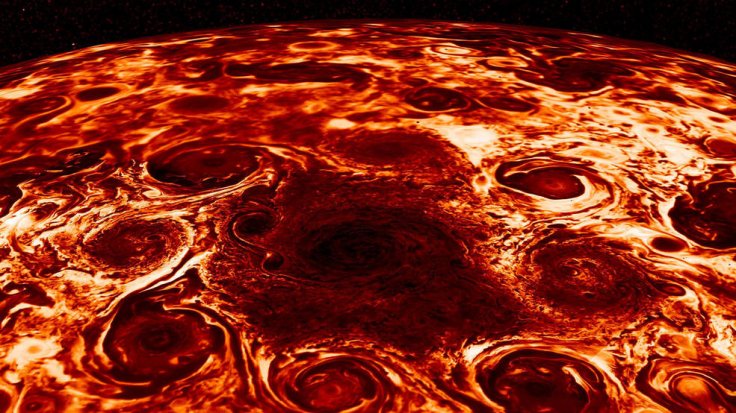
NASA scientists woke up to find 'unprecedented' weather info on Jupiter's interior sent by Juno spacecraft showing the solar system's largest planet's surface with a swirling mixture of liquid hydrogen and helium.
NASA's Juno, orbiting Jupiter since 2016, has sent the latest images and info about what's lying below the planet's outer surface seen as thick red, brown, yellow and white clouds as shown in the picture. The upbeat scientists termed it unprecedented insight beneath the known clouds of Jupiter.
"Juno is designed to look beneath these clouds," said Yohai Kaspi of the Weizmann Institute of Science in Israel, who is part of the research team using Juno's data. Jupiter is a gaseous planet without a solid surface, only information from orbit can be gathered, said scientists.
Jupiter is the fifth planet from the sun and the largest in our solar system measuring about 89,000 miles in diameter, compared with Earth's 8,000 miles. Unlike rocky planets like Earth and Mars, Jupiter has 99 percent hydrogen and helium. Scientists believe that deep under the surface, Jupiter's gas is getting ionized and may eventually turn into a hot, dense metallic liquid.
Jupiter is known for its familiar jet streams, which plunge below 1,800 miles beneath the clouds. The interior of Jupiter, comprising of fluid hydrogen and helium mixture, rotates as if it is a solid body or any other planet. "The very center may contain a core made of high-pressure and high-temperature rocks and perhaps water, but it is believed to be fluid as well, not solid," said another planetary scientist Tristan Guillot from the Université Côte d'Azur in Nice.
The computer-generated cyclonic pattern over Jupiter's south pole shows that it contains a central cyclone, surrounded by five cyclones with diameters ranging from 3,500 to 4,300 miles. The latest Juno's data shows asymmetry between the gravitational field of Jupiter's northern and southern hemispheres, due to the jet streams. The deeper the jets streams go, the more mass they contain, exerting a strong effect on Jupiter's gravitational field, said Yohai Kaspi.
NASA's spacecraft Cassini sent to explore Saturn had earlier shown that Saturn has a single cyclonic vortex at each pole. With different data sent from Juno, NASA scientists have realized that not all gas planets are created equal.
"Prior to Juno we did not know what the weather was like near Jupiter's poles. Now, we have been able to observe the polar weather up-close every two months," said Alberto Adriani from the Institute for Space Astrophysics and Planetology, Rome, and lead author of the paper. "Each one of the northern cyclones is almost as wide as the distance between Naples, Italy and New York City -- and the southern ones are even larger than that," he noted.
The research was published in the journal Nature.
Launched in August 2011, Juno has reached as low as the planet's cloud tops at about 2,200 miles. It is probing beneath the obscuring cloud cover of Jupiter, and has so far completed 10 science passes over Jupiter and logged almost 122 million miles. Its next science pass will be on April 1.








